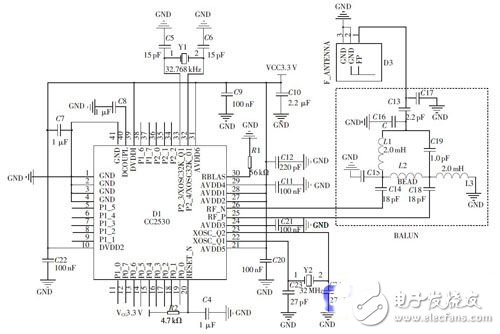ZigBee's next-generation SoC chip, the CC2530, is TI's system-on-chip for embedded applications and is a system-on-a-chip solution using the IEEE 802.15.4 standard, ZigBee and ZigBee RF4CE. An 8051 microprocessor and high-performance RF transceiver have been integrated inside the CC2530. The CC2530 is capable of building powerful network nodes at very low total material cost, with large flash memory and storage capacity of up to 256 B. It is the ideal ZigBee professional application chip; ZigBee RF4CE supporting the new RemoTI, this is The industry's first ZigBeeRF4CE compliant protocol stack. In addition, the CC2530 has different operating modes, making it especially suitable for systems with ultra-low power requirements. The transition time between operating modes is short, further ensuring low energy consumption. Figure 3 shows the CC2530 peripheral circuit design. The D3 inverted F antenna in the figure is a single-ended antenna, that is, an unbalanced antenna. Therefore, a capacitor and inductor are required to form a balun (BALUN), as shown in the dotted line block diagram to meet the requirements of RF input/output matching.

Figure 3 CC2530 peripheral circuit
PCB antenna design is difficult and usually requires the support of simulation tools, but TI has announced the specifications for the inverted F-type PCB antenna design. For the design of terminal equipment, PCB antenna is a more economical choice, because its communication distance can meet the requirements of this system. The street lamp node design adopts the method of photosensitive resistance sensor detection to collect the street lamp state information and transmit it back to the main control center (coordinator) by wireless. At the same time, after the main control center processes, the corresponding control command is sent to the designated street lamp node. The coordinator is designed to control the street lights of the entire network based on the precise time generated by the electronic clock and the intensity of the external light collected by the photoresistor. In the middle of the night, the partition light is turned on (the partial light is turned on) to reduce the power consumption. In the daytime, the method of turning off all the street lights is used. If the weather suddenly turns negative, the system will automatically turn on some of the street lights to meet the lighting requirements; Use the intensity of the light collected by the light sensor to determine whether the light needs to be turned on or off, so that the light can be turned on and off in time. Intelligent and energy-saving control is achieved based on the above controls. Table 1 shows the status of the main control street light of the coordinator (this table is based on the actual situation of the city).
Garden Equipment,Garden Pond Water Pump,Low Voltage Pond Pumps,Swimming Pool Pump
Sensen Group Co., Ltd.  , https://www.sunsunaquariums.com